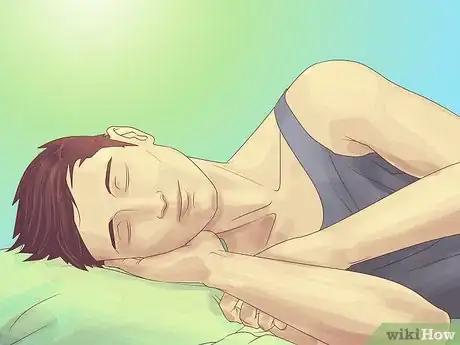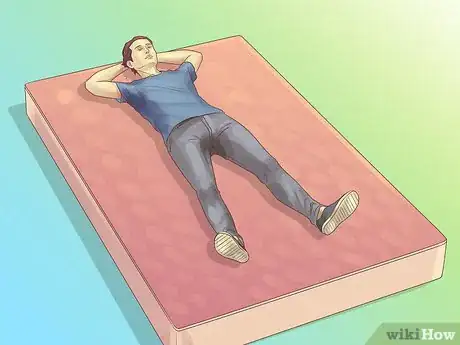This article was co-authored by Kathryn Kellogg. Kathryn Kellogg is the founder of goingzerowaste.com, a lifestyle website dedicated to breaking eco-friendly living down into a simple step-by-step process with lots of positivity and love. She's the author of 101 Ways to Go Zero Waste and spokesperson for plastic-free living for National Geographic.
wikiHow marks an article as reader-approved once it receives enough positive feedback. In this case, 88% of readers who voted found the article helpful, earning it our reader-approved status.
This article has been viewed 167,328 times.
Getting a good night's rest is essential for short and long-term health, so it's important to choose a mattress that complements your body's physical needs and sleeping patterns. Other considerations, such as your partner's preferences and your budget, may also factor in to your decision-making process when you're mattress shopping. This article provides information on different types of mattresses available, how to choose and buy a mattress from the mattress store, and how to make sure the mattress you buy is right for you before making it a permanent fixture of your bedroom.
Steps
Preparing to Buy a Mattress
-
1Know the different mattress options. Mattresses range from classic firm or plush options to higher-tech mechanically-operated beds with remote controls. Do some research on these commonly available options:[1]
- Basic firm or plush mattresses. Basic mattresses are made from a variety of materials and are sold at every price range. Mattresses made with organic or natural fibers tend to be more expensive. You'll be able to choose from extra firm, firm, plush, and extra plush mattresses, depending on how soft or hard you like your bed to be.
- Memory foam mattresses. These mattresses are made from a material that molds to the shape of your body when you lie down, and holds that shape while you are sleeping. These are a good option for people who don't tend to move around a lot during the night. They retain body heat, so you may not want to go with memory foam if you tend to get hot while you sleep.
- Sleep number mattresses. These mattresses can be made harder or softer with the touch of a button. They are usually divided into different zones, so that your partner's side can have a different level of firmness than yours.
- Look into brand names, but don't be too biased. Sometimes brand names are better, but that doesn't mean you should overlook cheaper non-brand makes. A well-known name does not imply quality, though often times there is good reason for such a reputation. The important thing is to test mattresses in person and figure out what feels best for your own body.
- Understand that a high coil count doesn't necessarily translate into a higher-quality mattress. Mattresses with interlocking coils have coils that lock together. Mattresses with independent coils have a larger number of coils and are better for light sleepers, because they won't fluctuate as much with movement--especially when your partner shifts or gets out of bed.
-
2Have an understanding of your physical needs. Take the following elements into consideration:[2]
- Are you a side, back, or stomach sleeper? Some mattresses are designed to accommodate specific sleeping positions.
- Do you have mobility issues? Some mattresses are designed to make getting in and out of bed easier.
- Measure yourself and your sleeping partner. For most couples, a queen size bed will be large enough. If you are more than six feet tall, a king-size mattress may be a better choice. For a slender and tall mattress, go with the California king size.
Advertisement -
3Set your budget before you go shopping. Some mattresses cost many thousands of dollars, and others are under $500. Knowing exactly how much you're willing to spend before going to the store can eliminate confusion and prevent you from being talked into buying a mattress that's out of your price range.[3]
- The average market price for a solid mattress and box-frame set hovers around $800, with the costs of a quality bed ranging upwards of over $1500. If you can find a deal under your maximum price, go for it.
- Mattress stores sell a lot of extras, like mattress covers, pillow tops, bed frames, and other items you don't necessarily need. Know exactly what you're willing to buy before stepping into the store. Your mattress will work just as well without accessories, so don't buy them unless you want to.
-
1Try several mattress stores. Look online for reviews of mattress stores in your area, and plan to visit more than one. This will give you a broader view of the available options. If you see a mattress you love at the first location, you can always go back.
-
2Test mattresses in the mattress showrooms. Get a feel for different mattress types by trying out mattresses of varying levels of thickness and firmness. If a mattress doesn't feel comfortable in the showroom, it probably won't feel better at home.
- Test more expensive mattresses first, to experience what a high quality mattress feels like. Compare it to the lower end mattresses until you find one that meets your requirements for both comfort and cost.
- Spend more than 10 seconds lying on each mattress. Allow yourself to actually rest for a minute. If you're too tense or impatient with the process you won't get to experience how it actually feels to rest on the mattress, and you may be disappointed once you bring it home.
-
3Feel free to negotiate. Most mattress salespeople are open to throwing in a few extras or lowering the price to make the sale. If you're paying full price, ask if they'll include a box spring, bed frame or pillow top.
- Make sure your mattress comes with a warranty, so that you'll be able to return it to the store if you change your mind or if it turns out to be defective. Most warranties allow you to return the mattress within 30 to 60 days.
- Most mattress purchases include free delivery, and some companies will dispose of your old mattress.
Confirming Your Decision at Home
-
1Make the most of your trial period. It takes a little while for the body to get accustomed to a new mattress, so start really paying attention to the way it makes you feel after about three days. Think about these questions:[4]
- How many hours of sleep do you get on the new mattress?
- Do you toss and turn or sleep soundly?
- Do you feel achy or sore during the day?
- Does your back feel supported, or do you sink into the mattress uncomfortably?
- Do you feel well rested, regardless of how much sleep you get?
-
2If necessary, return the mattress. If you aren't sleeping well on your new bed, it's best to return it. Start the process of choosing and buying a mattress again, taking into account the factors that made the old one inappropriate for your needs.
Community Q&A
Did you know you can get expert answers for this article?
Unlock expert answers by supporting wikiHow
-
QuestionWhich type of mattress is the best?
 Kathryn KelloggKathryn Kellogg is the founder of goingzerowaste.com, a lifestyle website dedicated to breaking eco-friendly living down into a simple step-by-step process with lots of positivity and love. She's the author of 101 Ways to Go Zero Waste and spokesperson for plastic-free living for National Geographic.
Kathryn KelloggKathryn Kellogg is the founder of goingzerowaste.com, a lifestyle website dedicated to breaking eco-friendly living down into a simple step-by-step process with lots of positivity and love. She's the author of 101 Ways to Go Zero Waste and spokesperson for plastic-free living for National Geographic.
Sustainability Specialist
-
QuestionWhich type of mattress is least likely to form body indentations over time?
 Community AnswerA memory foam mattress. They're very comfy and can form to your body as long as you stay on it.
Community AnswerA memory foam mattress. They're very comfy and can form to your body as long as you stay on it. -
QuestionWhich brand is better - Orthopedic or Theramedic?
 Community AnswerIt depends on your preferences. Try both and see which you like best!
Community AnswerIt depends on your preferences. Try both and see which you like best!
References
About This Article
To choose a mattress, pick a memory foam mattress if you want one that molds to the shape of your body. Alternatively, choose a basic firm or plush mattress for a cooler bed, since memory foam retains body heat. Additionally, select a mattress with independent coils if you’re a light sleeper, because the coils won’t move when your partner moves. You may also want to consider a sleep number mattress, which is divided into zones that you can make harder or softer at the touch of a button. For more tips, including how to negotiate the purchase of your new mattress, keep reading!































































